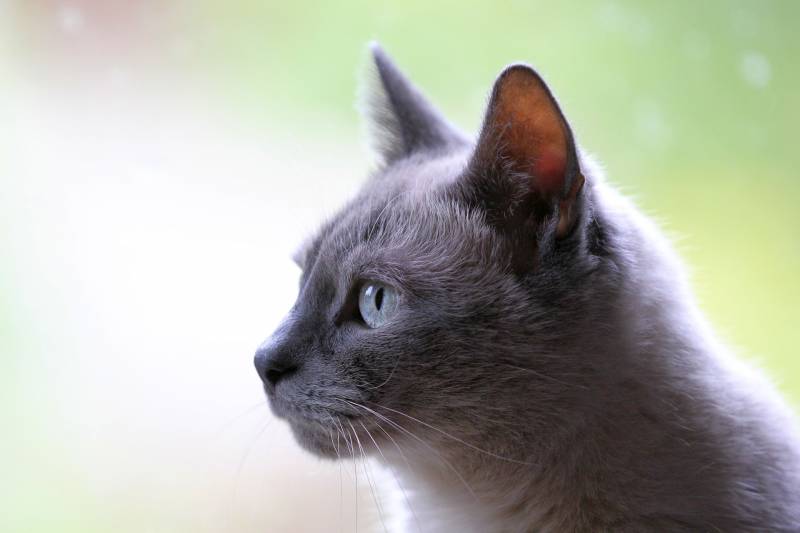Quick Navigation
Cats make devoted companions, so putting down a cat with stomatitis wouldn’t be easy.
It can be upsetting when he isn’t his calm, devoted self because of illness and pain.
Perhaps you’re beginning to notice he is drooling and constantly pawing at his mouth, and you’ve discovered the cause – stomatitis.
Don’t be misled – feline stomatitis has nothing to do with pain in the stomach.
It is actually a very painful inflammation of the mouth and gums.

Your feline pet is miserable, and the thought of putting a cat down with stomatitis has probably crossed your mind.
But this surely has to be your last resort.
A full physical exam by the vet can put your mind at rest.
Sometimes Stomatitis can be Fatal
Feline stomatitis or feline chronic gingivostomatitis is fairly common in cats of all ages and breeds.
Many assume anything that has to do with the teeth and gums is associated with senior cats.
1. Ensure Good Oral Hygiene
It’s not only a senior cat health issue because stomatitis can happen in younger cats too.
When you bring a cat into your home, plaque control and dental hygiene will be important.
Professional dental cleanings will remove plaque for a while, but it will return.
Dental care is an ongoing preventative procedure.
Certainly, if you suspect your cat has a problem with his teeth and gums, get him to the vet as soon as possible.
Stomatitis is a seriously painful oral disease.
You don’t have to assume that putting a cat down with stomatitis is inevitable.
There are two kinds of stomatitis.
One type refers to inflammation of the gums around the teeth, while the other affects the back of the mouth.
This kind of stomatitis is referred to as caudal stomatitis.
2. Look Out for Symptoms
The inflammation is painful for your cat, and you need to know that it can sometimes be fatal.
Putting a cat down with stomatitis could be your sad reality.
Hopefully, you won’t need to do that because treatment from the vet can help your cat.
It can live comfortably in this condition.
Some of the symptoms of stomatitis can include the following:
- pawing at the mouth
- bad breath
- drooling
- doesn’t want to eat
- losing weight
The cat has become overly sensitive to its plaque.
Plaque causes the immune system to mount an inflammatory response with lymphocytic cells entering the cats’ gums and oral tissues.
Extraction is essentially the only way to bring lasting relief to a cat.
3. Full Mouth Extractions
Even researchers don’t seem to know the cause of stomatitis.
Many vets can’t give you an answer to the cause of this inflammatory condition either.
They will say that they can’t offer a cure because they don’t know the cause.
However, they might also say that they can offer a treatment strategy that brings relief to cats.
This treatment is the extraction of all the teeth.
Full-mouth or partial-mouth extractions can extend your cat’s life and bring about tremendous pain relief.
Surgical treatments like this provide the best chance for a cure.
Pet owners who don’t want their cats to endure long-term treatment only to have the stomatitis return reach out to this dental surgery.
It can spare their cats from the side effects of the drugs.
4. Avoid Putting Your Cat Down
Putting a cat down with stomatitis can be avoided by taking this route.
Many cat owners have tried to manage feline stomatitis with medication.
Unfortunately, they have sadly seen the inflammation return with a vengeance.
Vets will do everything they can before putting a cat down with stomatitis.
So if your cat receives anti-inflammatory therapy, it will require regular checkups.
Once the inflammation is controlled, check-up visits become less frequent.
There may be side effects such as restlessness, irritability, and weight gain, but it’s better than putting a cat down with stomatitis.
Yes, putting a cat down with stomatitis is an option for cats who show a poor response to therapy and are in constant pain and discomfort.
Stomatitis Causes an Unbearable Pain
When looking at your feline friend, one of the signs that will give away the disease is the agonizing pain when it opens its mouth.
Your cat may meow or squeal in pain when he wants to eat or even when he yawns.
You can see his red, inflamed, and ulcerated gums when he yawns.
If the condition continues for a while, your cat will lose weight.
Because the disease is slow and takes a while to make itself evident, it may not even be detected early.
The lesions may have become more severe.
When you get your cat to the vet, the pain may be so severe that your vet needs to first give an anesthetic before examining your cat’s mouth.
Dental x-rays will be crucial for a diagnosis.
Oral biopsies will be taken to confirm the diagnosis.
The teeth of your cat will have to be cleaned of all plaque.
This can only be accomplished under anesthesia.
Your cat may also be given antibiotics and anti-inflammatory steroids.

Is Feline Stomatitis Contagious?
Fortunately, feline stomatitis is not contagious.
However, what may have caused it is contagious.
One example is the feline calicivirus which is highly contagious.
According to Cornell University College of Veterinary Medicine, feline calicivirus causes “a mild to severe respiratory infection and oral disease in cats.”
It can even be transmitted to humans too.
So, it’s important to be careful around your cat when it has stomatitis because you’ll never know what caused it until it could be too late.
Will Your Cat Need to be Euthanized?
When your vet tells you that a full-mouth extraction of all teeth is required, you must wonder if putting a cat down with stomatitis is the only way.
Partial- or full-mouth extractions can provide improvement with an affected cat when done early.
Also, no root tips must be left behind.
You may think that a cat having all its teeth extracted is like a death sentence for the cat.
Of course, not having teeth can be a bit of an inconvenience.
But did you know that cats essentially don’t need teeth?
Yes, cats in the wild still rely on their teeth to chew on the mice and birds they catch.
However, domesticated cats don’t have to have teeth, and they can happily live without them.
However, some cat owners do choose humane euthanasia.
They can see that the pain continues after exhausting all treatment options.
There are many other treatments for feline stomatitis.
Some people have tried good oral hygiene, dental cleanings, periodontal therapy, and laser therapy.
None have brought the long-term resolution they’ve wanted for their beloved pet.
Will they have to put their cat down?
Repeated corticosteroids may be required without surgery and a partial- or full-mouth extraction.
However, treatment could eventually become ineffective.
Stomatitis is a dreadful disease for a cat to get.
It can affect your pet’s quality of life.
Your cat can scarcely eat, so he won’t get the nutrients he needs.
So yes, unfortunately, it can mean putting your pet down.
It usually becomes the decision owners take when the inflammation persists, even after thorough dental cleaning and medications.
Conclusion
Feline stomatitis can be excruciatingly painful for your cat.
It’s an inflammatory illness that vets say is far easier to control than cure.
With aggressive treatment putting a cat down with stomatitis can be avoided.
In fact, the good news is that stomatitis in cats is rarely fatal.
However, it is serious and can’t be ignored.
Tooth extraction is the lifeline held out to your cat.
Without his teeth, his diet may have to be somewhat changed.
Yet it’s a very small price to have your four-legged furry friend with you, healthy and happy.
Teeth extractions can lend your cat to you many more years.

A passionate content creator on pet behavior, nutrition choices, and health, Mike is an experienced pet expert. He has been writing on multiple websites to compensate for his passion for cats. Mike grieves around plenty of pets in his parents’ house. At the start of his career, he had a sturdy intention to be a part of pet care by any means.
With his affiliation to Purrfect n’ Pawesome, he found a way to satiate his craving to participate in pet health, wellness, and behavior analysis. He has been a significant part of our team and a major contributor in equipping our site with useful, authentic, and research-backed articles.
“I love pets as much as I love to travel to explore multiple places and lifestyles. I have been attached to this pawsome platform for many years, and my experience regarding pets has enhanced significantly by using various devices to write articles. I believe in writing my thoughts and experiences, so I try to write down the experience and learnings for my readers no matter where I am and what my mood is.”

